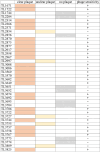Quorum sensing gene lasR promotes phage vB_Pae_PLY infection in Pseudomonas aeruginosa
- PMID: 38858621
- PMCID: PMC11163716
- DOI: 10.1186/s12866-024-03349-7
Quorum sensing gene lasR promotes phage vB_Pae_PLY infection in Pseudomonas aeruginosa
Abstract
Background: Quorum sensing (QS) is a cell density-based intercellular communication system that controls virulence gene expression and biofilm formation. In Pseudomonas aeruginosa (P. aeruginosa), the LasR system sits at the top of the QS hierarchy and coordinates the expression of a series of important traits. However, the role of lasR in phage infection remains unclear. This study aims to investigate the role of lasR QS in phage infection.
Methods: The P. aeruginosa phage was isolated from sewage, and its biological characteristics and whole genome were analyzed. The adsorption receptor was identified via a phage adsorption assay. Following lasR gene knockout, the adsorption rate and bactericidal activity of phage were analyzed. Finally, real-time quantitative polymerase chain reaction (RT-qPCR) was conducted to explore how lasR promoting phage infection.
Results: The lytic phage vB_Pae_PLY was isolated and lipopolysaccharide (LPS) was identified as its adsorption receptor. The adsorption rate and bactericidal activity of vB_Pae_PLY were reduced after lasR knockout. RT-qPCR results showed that the expression of galU, a key gene involved in LPS synthesis, was down-regulated, and several genes related to type IV pili (T4P) were also down-regulated in the lasR mutant PaΔlasR.
Conclusions: The study showed that QS lasR may promote phage vB_Pae_PLY infection by involving in the synthesis of LPS and T4P. This study provides an example of QS in promoting phage infection and deepens the understanding of phage-bacteria interactions.
Keywords: Pseudomonas aeruginosa; lasR; Phage infection; Phage receptor; Quorum sensing.
© 2024. The Author(s).
Conflict of interest statement
The authors declare no competing interests.
Figures








Similar articles
-
Phage-host interaction in Pseudomonas aeruginosa clinical isolates with functional and altered quorum sensing systems.Appl Environ Microbiol. 2025 Apr 23;91(4):e0240224. doi: 10.1128/aem.02402-24. Epub 2025 Mar 4. Appl Environ Microbiol. 2025. PMID: 40035599 Free PMC article.
-
Quorum Sensing Promotes Phage Infection in Pseudomonas aeruginosa PAO1.mBio. 2022 Feb 22;13(1):e0317421. doi: 10.1128/mbio.03174-21. Epub 2022 Jan 18. mBio. 2022. PMID: 35038901 Free PMC article.
-
LasR Variant Cystic Fibrosis Isolates Reveal an Adaptable Quorum-Sensing Hierarchy in Pseudomonas aeruginosa.mBio. 2016 Oct 4;7(5):e01513-16. doi: 10.1128/mBio.01513-16. mBio. 2016. PMID: 27703072 Free PMC article.
-
Expression of a Phage-Encoded Gp21 Protein Protects Pseudomonas aeruginosa against Phage Infection.J Virol. 2022 Mar 9;96(5):e0176921. doi: 10.1128/JVI.01769-21. Epub 2022 Jan 12. J Virol. 2022. PMID: 35020473 Free PMC article.
-
An evolving perspective on the Pseudomonas aeruginosa orphan quorum sensing regulator QscR.Front Cell Infect Microbiol. 2014 Oct 28;4:152. doi: 10.3389/fcimb.2014.00152. eCollection 2014. Front Cell Infect Microbiol. 2014. PMID: 25389523 Free PMC article. Review.
Cited by
-
Phage-Antibiotic Synergy Enhances Biofilm Eradication and Survival in a Zebrafish Model of Pseudomonas aeruginosa Infection.Int J Mol Sci. 2025 Jun 1;26(11):5337. doi: 10.3390/ijms26115337. Int J Mol Sci. 2025. PMID: 40508147 Free PMC article.
-
Isolation, characterization and therapeutic efficacy of lytic bacteriophage ZK22 against Salmonella Typhimurium in mice.BMC Microbiol. 2025 Jan 22;25(1):39. doi: 10.1186/s12866-025-03772-4. BMC Microbiol. 2025. PMID: 39844042 Free PMC article.
-
The Role of Quorum Sensing in Phage Lifecycle Decision: A Switch Between Lytic and Lysogenic Pathways.Viruses. 2025 Feb 26;17(3):317. doi: 10.3390/v17030317. Viruses. 2025. PMID: 40143247 Free PMC article. Review.
References
MeSH terms
Substances
Grants and funding
LinkOut - more resources
Full Text Sources

